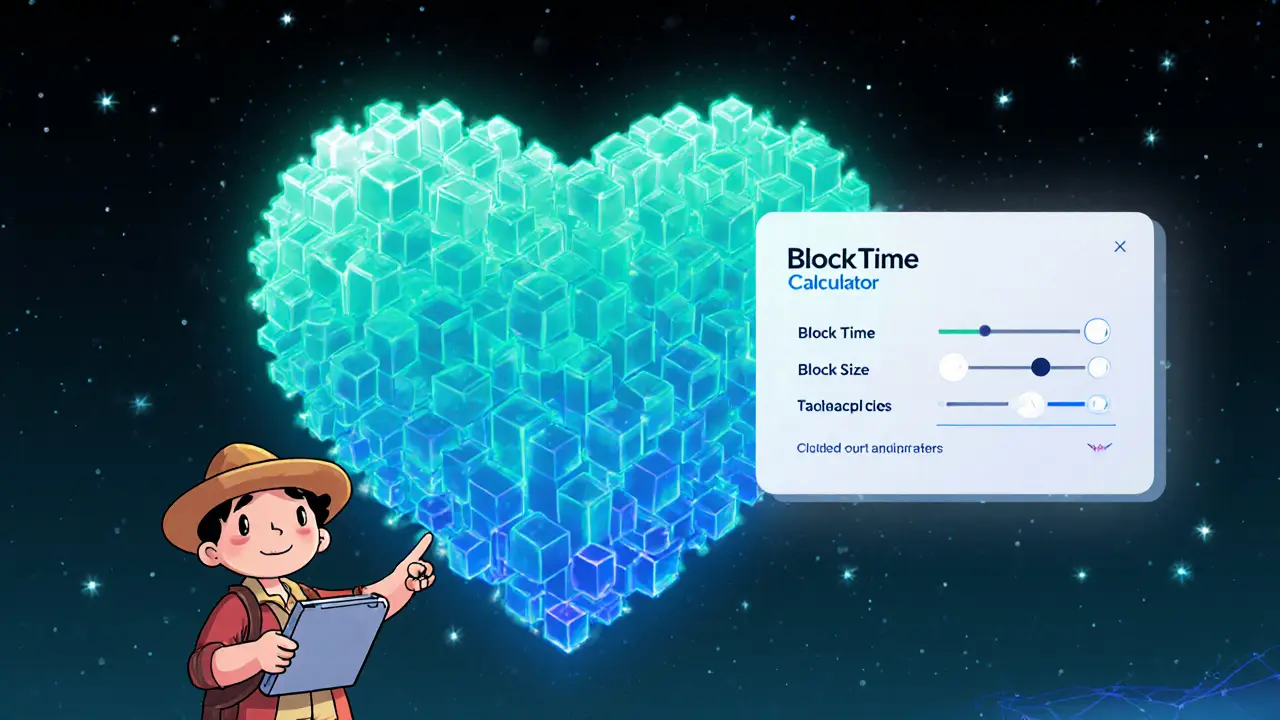Blockchain Speed Calculator
Estimated Transaction Throughput
Comparison Table
| Chain | Block Time | Typical TPS |
|---|---|---|
| Bitcoin | 10 minutes | 7 TPS |
| Ethereum | 12 seconds | ≈30 TPS |
| Solana | 400 milliseconds | ≈65,000 TPS |
| Polygon | 2 seconds | ≈7,000 TPS |
Block time is a measure of the average interval between the creation of successive blocks in a blockchain. It acts like the heartbeat of any distributed ledger: the faster the beat, the sooner a transaction can be confirmed. Understanding how this heartbeat works helps you predict confirmation delays, estimate fees, and decide whether a given chain fits your use case.
Quick Take
- Block time = average time to add a new block.
- Shorter block times boost transaction throughput but can weaken security.
- Bitcoin’s 10‑minute block time limits it to ~7TPS.
- Layer‑2 solutions (e.g., Lightning Network) sidestep the base‑layer limitation.
- Choosing a blockchain is a trade‑off between speed, decentralization, and security.
Why Block Time Matters for Speed
The moment a user sends a payment, the network has to bundle that payment into a block. Until the block lands on the chain, the transaction stays in a mempool, waiting for a miner or validator to grab it. If the chain’s block time is 10minutes, the earliest possible confirmation is just under 10minutes; in practice it often takes longer because the network prioritizes higher‑fee transactions.
Transaction speed, measured in confirmations per second (or simply how quickly a user sees a "completed" status), is directly proportional to how many blocks can be produced in a given period. A chain that mines a block every 10seconds can theoretically confirm up to six times more transactions than one that waits 1minute.
Bitcoin’s 10‑Minute Design: Security Over Speed
Bitcoin is the first decentralized cryptocurrency, designed with a 10‑minute block time to maximize security and decentralization. The long interval gives the network ample time to propagate a new block worldwide before the next one is attempted, reducing the chance of accidental forks.
Bitcoin also uses a Difficulty retargeting algorithm that recalibrates the mining difficulty every 2,016 blocks (roughly two weeks) to keep the average block time close to 10 minutes. If many miners join and blocks start arriving faster, the difficulty spikes, making new blocks harder to find. Conversely, if miners leave, difficulty drops.
This self‑balancing system guarantees a predictable schedule, but it also caps throughput. With a 1MB block size and an average transaction size of ~250bytes, Bitcoin can fit roughly 4,000 transactions per block, translating to about 7transactions per second (TPS). Compare that to Visa’s ~24,000TPS and you see why Bitcoin is often called “digital gold” rather than a day‑to‑day payment rail.
Faster Block Times in Other Chains
Many newer blockchains have chosen shorter intervals to improve user experience:
| Chain | Block Time | Typical TPS |
|---|---|---|
| Ethereum | 12seconds | ≈30TPS |
| Solana | 400milliseconds | ≈65,000TPS (theoretical) |
| Polygon | 2seconds | ≈7,000TPS |
Shorter block times boost TPS, but they also increase the likelihood of temporary forks, demand more bandwidth from nodes, and can concentrate validation power in fewer hands-i.e., centralization pressure.

The Blockchain Trilemma: Speed, Security, Decentralization
The blockchain trilemma describes the difficulty of achieving decentralization, security, and scalability simultaneously. Reducing block time improves scalability (more transactions per second) but may erode security (less time for nodes to verify and propagate blocks) and decentralization (only well‑resourced validators can keep up).
In practice, projects pick a point on the triangle that matches their target market. Bitcoin sits near the security‑decentralization corner, while Solana leans toward scalability. Understanding where a chain sits helps you decide if its speed is suitable for your application.
Layer‑2 Solutions: Getting Speed Without Changing Block Time
Because Bitcoin’s base layer is unlikely to shrink its 10‑minute interval, developers built Lightning Network a Layer‑2 protocol that enables near‑instant, low‑fee Bitcoin payments by moving most transactions off‑chain. Users open a payment channel, settle many tiny payments instantly, and only broadcast the final balance to the main chain.
Other Layer‑2 ideas include State Channels, Sidechains, and Nested Blockchains. They share a common goal: keep the main chain’s security guarantees while offering sub‑second confirmation times for end‑users.
Practical Tips for Users and Developers
- Estimate fees based on desired confirmation time. Higher fees push miners to include your transaction in the next block.
- Know the confirmation policy of the service you use. Exchanges often wait for 6‑8 Bitcoin confirmations (≈1hour) for large deposits.
- Design UI flows that set realistic expectations. Show a progress bar that maps mempool status to estimated block time.
- If you need sub‑second finality, integrate a Layer‑2 solution instead of relying on the base chain.
- Monitor network health. Sudden spikes in hash rate can temporarily alter actual block intervals.
Developers should also handle edge cases where a block takes longer than average-perhaps due to a temporary dip in mining power. Implement retries and clear user messages to avoid confusion.
Future Outlook: Will Block Time Change?
Most of the Bitcoin community agrees that altering the 10‑minute target would jeopardize the security model that has proven robust for over a decade. Instead, research focuses on improving Layer‑2 ergonomics, cross‑chain bridges, and better fee estimation tools.
For newer chains, some experiments aim to use adaptive block times-slow down during network stress, speed up when demand is low-to balance security and performance dynamically. These ideas are still in early stages, but they illustrate that the industry continues to look for smarter ways to handle the speed‑security trade‑off.
Frequently Asked Questions
Why does Bitcoin take so long to confirm a transaction?
Bitcoin’s 10‑minute block time is a design choice to give the network enough time to spread new blocks worldwide, reducing the chance of forks and keeping the system secure.
Can I speed up a Bitcoin transaction?
Yes-by attaching a higher transaction fee you incentivize miners to include your transaction in the next block. Some wallets let you replace‑by‑fee (RBF) to bump the fee after broadcasting.
How does block time affect transaction throughput?
Throughput ≈ (block size ÷ average transaction size) ÷ block time. Shorter block times allow more blocks per hour, thus more transactions per second.
What is the Lightning Network and how does it solve the speed problem?
Lightning moves most payments off‑chain into payment channels that settle instantly. Only the final channel balance is written to Bitcoin’s blockchain, bypassing the 10‑minute wait.
Do all blockchains have the same block time?
No. Block times vary widely: Bitcoin ~10minutes, Ethereum ~12seconds, Solana ~400ms, and many Layer‑2 solutions aim for sub‑second finality.


Fionnbharr Davies
Block time is the heartbeat of any chain, setting the rhythm for how quickly transactions can be confirmed.
Shorter intervals mean validators can package new transactions faster, but they also raise the risk of forks.
When you look at Bitcoin’s ten‑minute cadence versus Solana’s sub‑second slots, the throughput difference is stark.
Designers have to balance security, decentralisation and user experience when picking a block time.
Keeping that balance in mind helps developers choose the right platform for their use case.